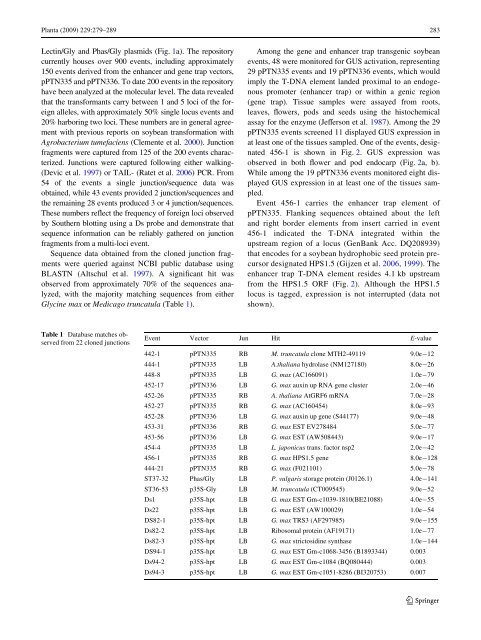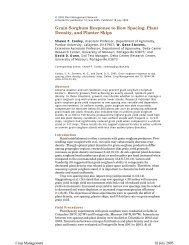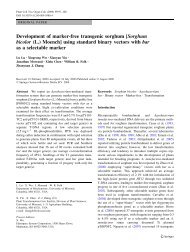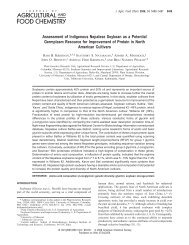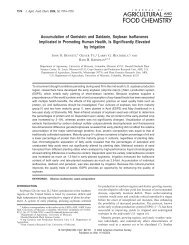Establishment of a soybean (Glycine max Merr. L ... - Plant Sciences
Establishment of a soybean (Glycine max Merr. L ... - Plant Sciences
Establishment of a soybean (Glycine max Merr. L ... - Plant Sciences
Create successful ePaper yourself
Turn your PDF publications into a flip-book with our unique Google optimized e-Paper software.
<strong>Plant</strong>a (2009) 229:279–289 283Lectin/Gly and Phas/Gly plasmids (Fig. 1a). The repositorycurrently houses over 900 events, including approximately150 events derived from the enhancer and gene trap vectors,pPTN335 and pPTN336. To date 200 events in the repositoryhave been analyzed at the molecular level. The data revealedthat the transformants carry between 1 and 5 loci <strong>of</strong> the foreignalleles, with approximately 50% single locus events and20% harboring two loci. These numbers are in general agreementwith previous reports on <strong>soybean</strong> transformation withAgrobacterium tumefaciens (Clemente et al. 2000). Junctionfragments were captured from 125 <strong>of</strong> the 200 events characterized.Junctions were captured following either walking-(Devic et al. 1997) or TAIL- (Ratet et al. 2006) PCR. From54 <strong>of</strong> the events a single junction/sequence data wasobtained, while 43 events provided 2 junction/sequences andthe remaining 28 events produced 3 or 4 junction/sequences.These numbers reXect the frequency <strong>of</strong> foreign loci observedby Southern blotting using a Ds probe and demonstrate thatsequence information can be reliably gathered on junctionfragments from a multi-loci event.Sequence data obtained from the cloned junction fragmentswere queried against NCBI public database usingBLASTN (Altschul et al. 1997). A signiWcant hit wasobserved from approximately 70% <strong>of</strong> the sequences analyzed,with the majority matching sequences from either<strong>Glycine</strong> <strong>max</strong> or Medicago truncatula (Table 1).Among the gene and enhancer trap transgenic <strong>soybean</strong>events, 48 were monitored for GUS activation, representing29 pPTN335 events and 19 pPTN336 events, which wouldimply the T-DNA element landed proximal to an endogenouspromoter (enhancer trap) or within a genic region(gene trap). Tissue samples were assayed from roots,leaves, Xowers, pods and seeds using the histochemicalassay for the enzyme (JeVerson et al. 1987). Among the 29pPTN335 events screened 11 displayed GUS expression inat least one <strong>of</strong> the tissues sampled. One <strong>of</strong> the events, designated456-1 is shown in Fig. 2. GUS expression wasobserved in both Xower and pod endocarp (Fig. 2a, b).While among the 19 pPTN336 events monitored eight displayedGUS expression in at least one <strong>of</strong> the tissues sampled.Event 456-1 carries the enhancer trap element <strong>of</strong>pPTN335. Flanking sequences obtained about the leftand right border elements from insert carried in event456-1 indicated the T-DNA integrated within theupstream region <strong>of</strong> a locus (GenBank Acc. DQ208939)that encodes for a <strong>soybean</strong> hydrophobic seed protein precursordesignated HPS1.5 (Gijzen et al. 2006, 1999). Theenhancer trap T-DNA element resides 4.1 kb upstreamfrom the HPS1.5 ORF (Fig. 2). Although the HPS1.5locus is tagged, expression is not interrupted (data notshown).Table 1 Database matches observedfrom 22 cloned junctionsEvent Vector Jun Hit E-value442-1 pPTN335 RB M. truncatula clone MTH2-49119 9.0e¡12444-1 pPTN335 LB A.thaliana hydrolase (NM127180) 8.0e¡26448-8 pPTN335 LB G. <strong>max</strong> (AC166091) 1.0e¡79452-17 pPTN336 LB G. <strong>max</strong> auxin up RNA gene cluster 2.0e¡46452-26 pPTN335 RB A. thaliana AtGRF6 mRNA 7.0e¡28452-27 pPTN335 RB G. <strong>max</strong> (AC160454) 8.0e¡93452-28 pPTN336 LB G. <strong>max</strong> auxin up gene (S44177) 9.0e¡48453-31 pPTN336 RB G. <strong>max</strong> EST EV278484 5.0e¡77453-56 pPTN336 LB G. <strong>max</strong> EST (AW508443) 9.0e¡17454-4 pPTN335 LB L. japonicus trans. factor nsp2 2.0e¡42456-1 pPTN335 RB G. <strong>max</strong> HPS1.5 gene 8.0e¡128444-21 pPTN335 RB G. <strong>max</strong> (F021101) 5.0e¡78ST37-32 Phas/Gly LB P. vulgaris storage protein (J0126.1) 4.0e¡141ST36-53 p35S-Gly LB M. truncatula (CT009545) 9.0e¡52Ds1 p35S-hpt LB G. <strong>max</strong> EST Gm-c1039-1810(BE21088) 4.0e¡55Ds22 p35S-hpt LB G. <strong>max</strong> EST (AW100029) 1.0e¡54DS82-1 p35S-hpt LB G. <strong>max</strong> TRS3 (AF297985) 9.0e¡155Ds82-2 p35S-hpt LB Ribosomal protein (AF19171) 1.0e¡77Ds82-3 p35S-hpt LB G. <strong>max</strong> strictosidine synthase 1.0e¡144DS94-1 p35S-hpt LB G. <strong>max</strong> EST Gm-c1068-3456 (B1893344) 0.003Ds94-2 p35S-hpt LB G. <strong>max</strong> EST Gm-c1084 (BQ080444) 0.003Ds94-3 p35S-hpt LB G. <strong>max</strong> EST Gm-c1051-8286 (BI320753) 0.007123


